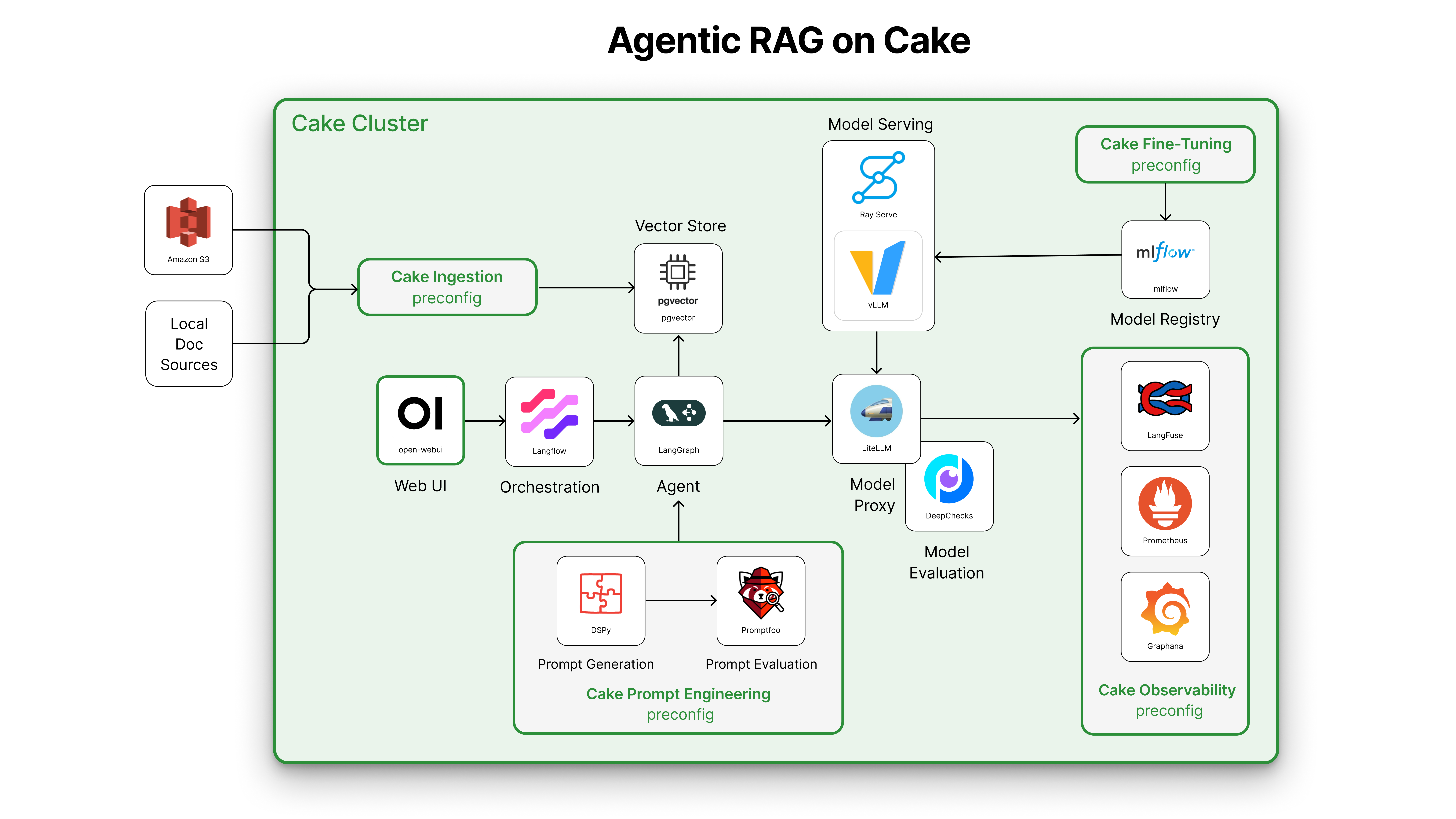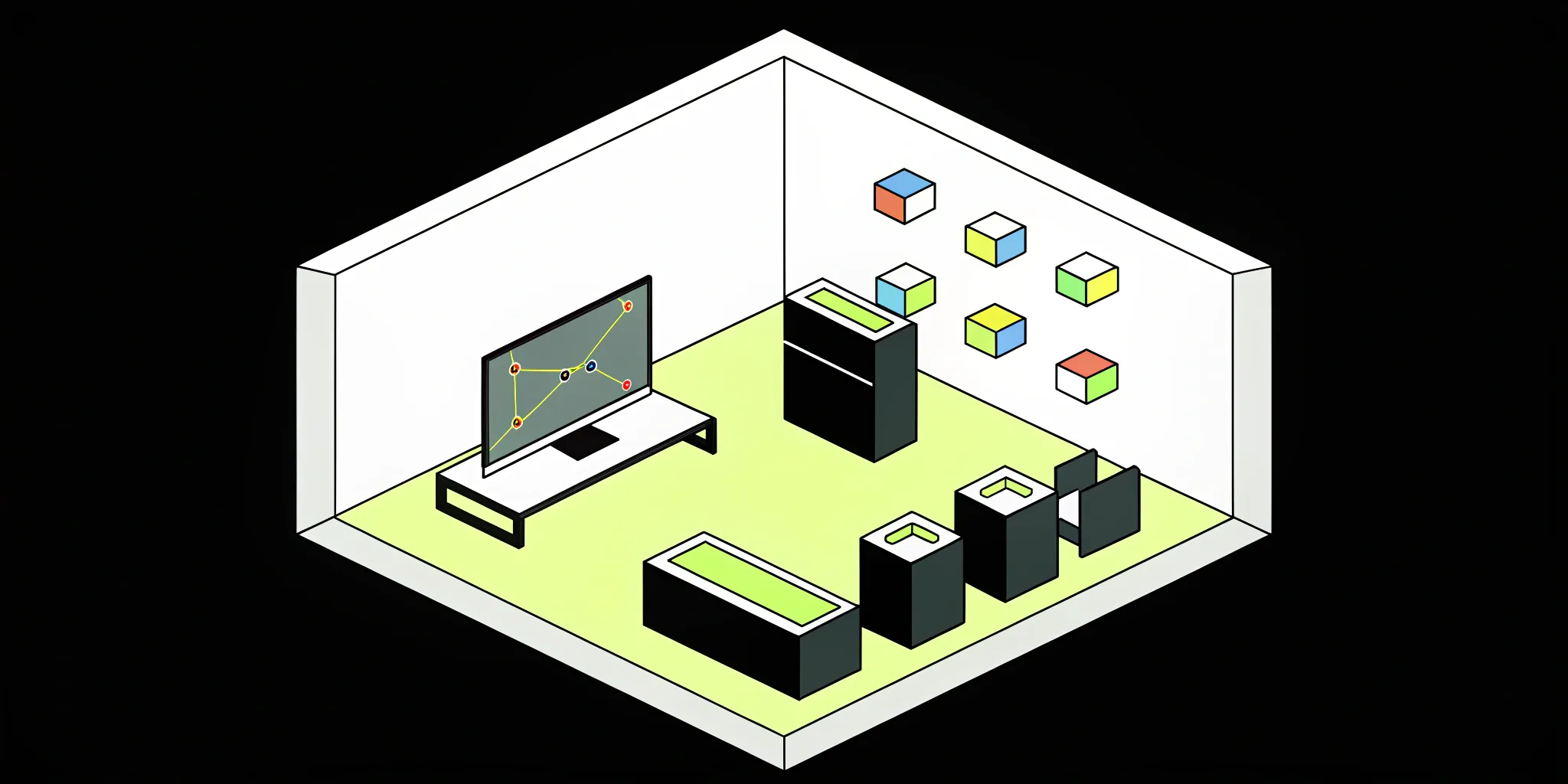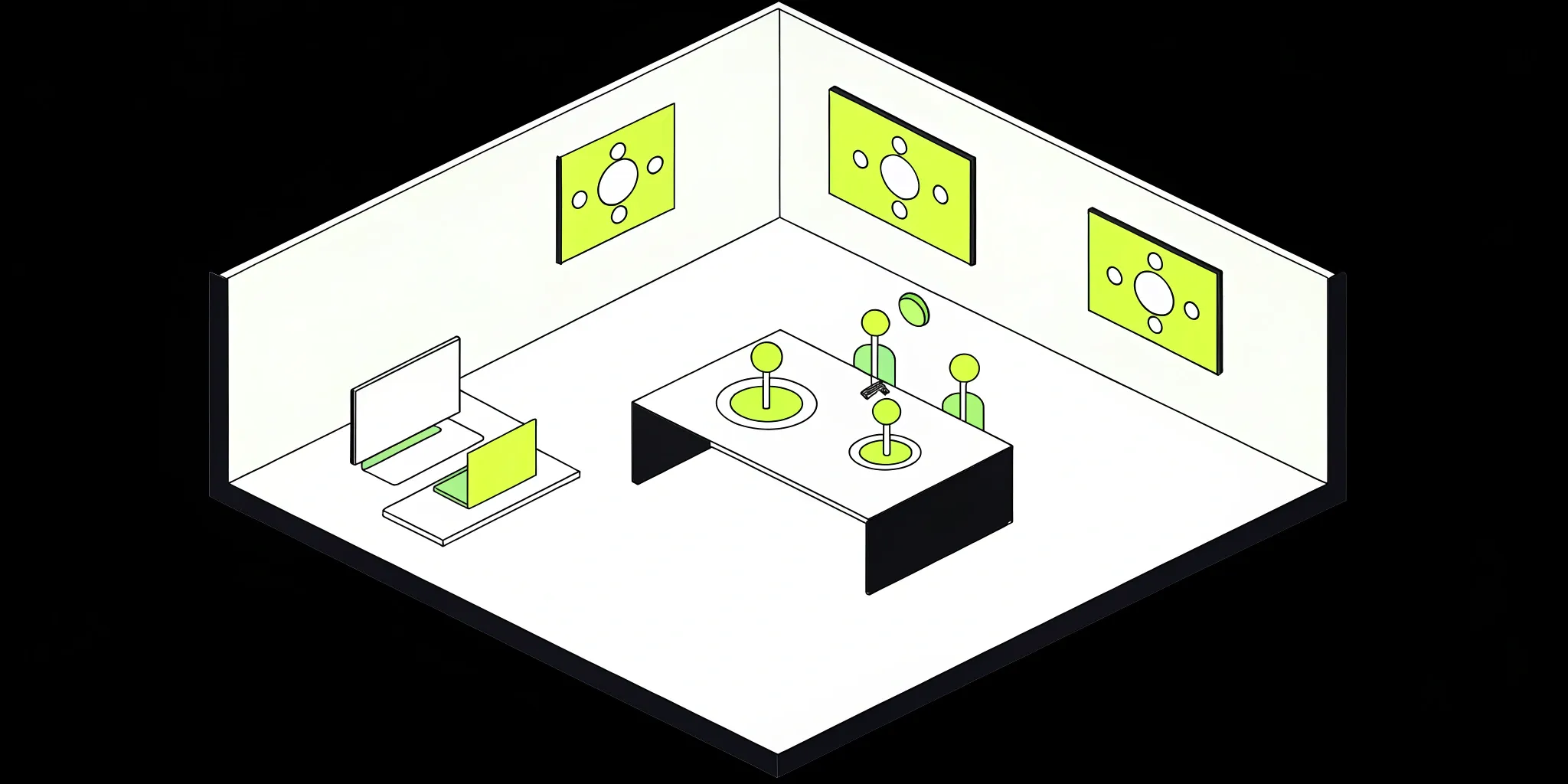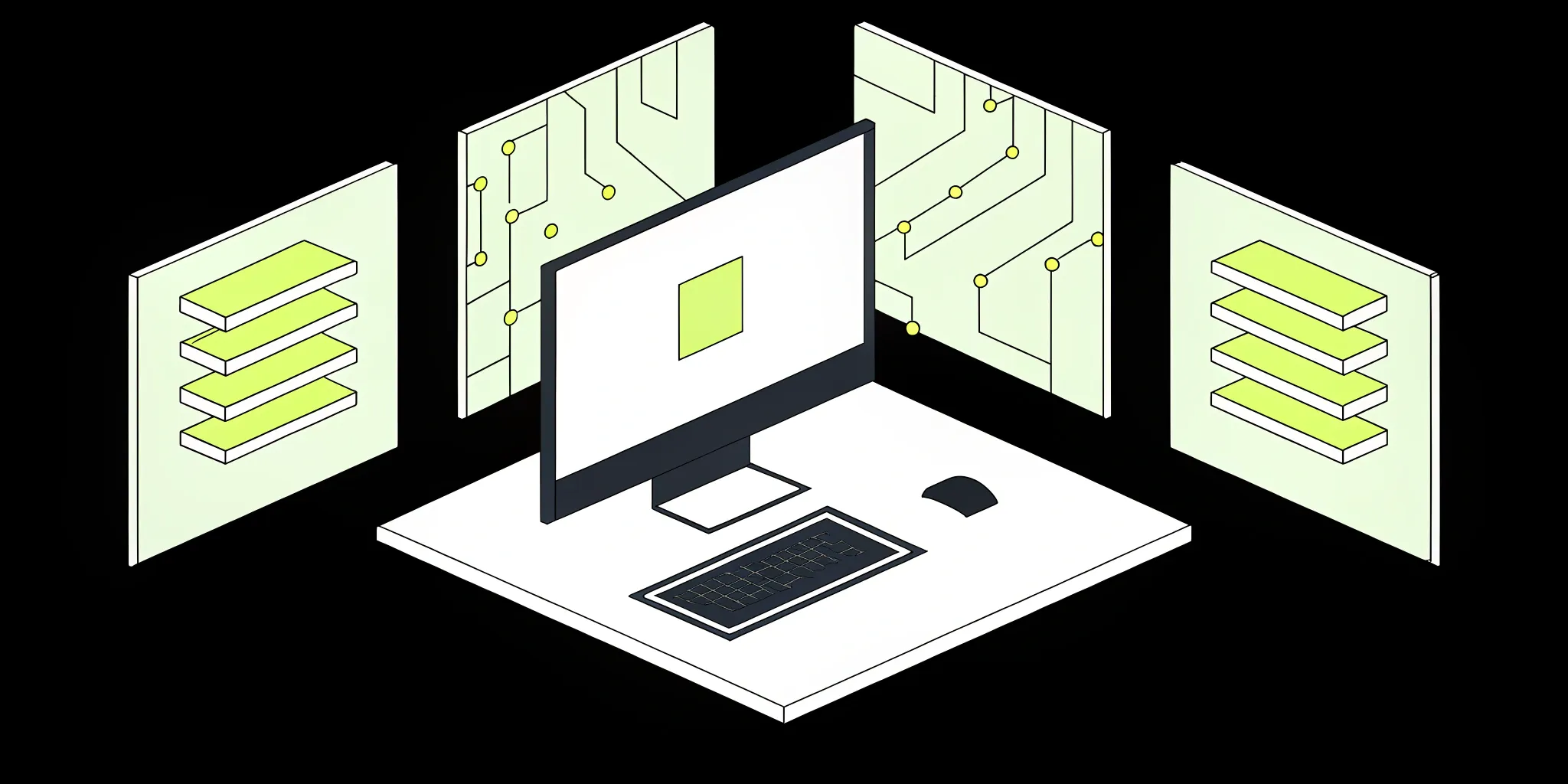How to Build an Agentic RAG Application

Your business probably stores its internal information in many formats and locations — as Word documents and Excel spreadsheets, in local and cloud databases, and real-time streams. Retrieval-Augmented Generative AI, or RAG for short, helps you find answers within all that data. It works by vectorizing your data sources and your prompt and then deciding which of the data sources are most ‘similar’ to the prompt. An Large Language Model (LLM) then uses those ‘similar’ sources as context when generating the answer to your question. An agentic RAG system, however, doesn’t stop there: it uses that answer to actually take useful actions on your behalf. For example, it can act as a helpdesk representative by handling customer support tickets; it can research and generate in-depth market analysis reports; or it can organize internal knowledge with an intelligence that feels almost human. By connecting dynamic data retrieval to autonomous agents, you create applications that don't just churn out answers but actively solve business problems. This guide is designed to give you the foundational knowledge and actionable steps you need to build an agentic RAG application that delivers real, measurable value and drives your organization forward.
Key takeaways
- Go beyond simple Q&A with agentic RAG: This approach transforms your AI from a passive information retriever into an active problem-solver. It autonomously analyzes user intent, plans the best course of action, and pulls from multiple sources to handle complex, multi-step tasks.
- Follow a methodical build process: A successful agentic RAG application isn't built on code alone. It requires a clear roadmap that includes preparing high-quality data, designing the system architecture, choosing the right tools, and committing to a continuous cycle of testing and refinement for peak performance.
- Prioritize features that drive autonomy: To create a truly effective application, focus on essential features like dynamic data retrieval for live information, deep contextual understanding to interpret user needs, and multi-agent collaboration to tackle complex requests. These capabilities enable powerful, real-world use cases that save your business time and money.
What are Agentic RAG applications?
If you're already using traditional RAG, you know it’s a powerful way to leverage the generative capabilities of LLMs with your own proprietary data sets. But what if your RAG system could do more than just fetch data and point out relevant documents? What if it could reason, plan, and decide on the best course of action all on its own and then execute on those actions? The main difference between traditional and agentic RAG comes down to one word: agency.
Think of Agentic RAG as the next step in the evolution of AI. It combines the data-retrieval strengths of traditional RAG with the autonomous, decision-making capabilities of AI agents such as LangChain. Instead of simply answering a question based on a static set of documents, an agentic RAG system analyzes a user's intent, determines what information it needs, and decides where to get it—whether from a database, an external API, or a real-time data stream. This approach moves your system from a simple Q&A tool to a proactive problem-solver, allowing you to build more dynamic and sophisticated AI applications that can handle complex, multi-step tasks without direct oversight. An Agentic RAG system is able to, for example, determine that a user's question requires financial data from one database and customer history from another, and then autonomously queries both to construct a complete response. This transforms the solution into an active agent, rather than a passive text generator.’
Breaking down the core components and architecture
To get a handle on how Agentic RAG works, it helps to picture it as a highly efficient team of specialists working together. The architecture generally consists of four core components. First is the Orchestrator, which acts as the project manager. It receives the user's request and delegates tasks to the right agents. Next are the Retrieval Agents, your team’s detectives. Their job is to hunt down the most relevant information from various sources. Then you have the Generation Agents, who are the writers that take the information gathered by the retrievers and craft it into a clear, coherent answer. Finally, there are Expert Agents, which are specialists trained on specific topics or tools, ready to be called upon when their unique knowledge is required.

How to build your agentic RAG application
Building an Agentic RAG application might sound complex, but it can be broken down into a few high-level steps:
- Formulate a clear problem statement
- Prepare and integrate the necessary relevant data sources
- Design the system at the component level
- Implement the system
- Test the results
BLOG: Deploy AI models to production nearly 4X faster with Cake
1. Decide what problem you’re actually trying to solve
There’s no point trying to build an Agentic RAG system simply because AI is cool and all your friends are using it. At the end of the day, Agentic RAG is a way of utilizing GenAI to address a real problem that your business is facing. Take the time to determine what the problem really is, what its ideal solution would be, and then identify the necessary tools to implement that solution. Agentic RAG is powerful and flexible, but don’t treat it as a sparkly trendy solution that needs a problem!
2. Prepare and integrate your data
Assuming that Agentic RAG is the right way to go about solving your problem, your system needs high-quality information to work with. This stage is all about gathering and organizing the data that will form your application's knowledge source and is the number-one factor in determining the quality of results that the finished system will achieve.
Identify the relevant data sources and determine the mechanics of how to connect to them and extract the necessary information. Clean it up by removing duplicates and fixing inconsistencies. Just as with traditional RAG, large documents must be broken into smaller, digestible pieces, a process called "chunking." These chunks are then converted into numerical representations, or "embeddings," and stored in a specialized vector database. This process enables your agent to find the most relevant information when answering a query quickly and is a crucial part of creating a knowledge base. Although chunking is easy to implement programmatically, various trade-offs must be considered when determining the optimal chunk size. So you can expect to iterate over this phase during the course of fine-tuning the overall system.
3. Design the system and integrate components
Once your data is prepared, it's time to design the system's architecture. This is where you create the blueprint for how your application will function. The core idea is to combine agentic AI’s decision-making capabilities with RAG’s powerful information retrieval functionality. Here, you'll map out how the agent analyzes a user's request, searches the vector database for relevant information, and uses that context to generate a thoughtful response. This phase also involves integrating key components, such as a reranker, which helps the system prioritize the most important pieces of retrieved information. This ensures the final output is not only accurate but also highly relevant to the user's original intent.
4. Write and implement the code
Now it's time to bring your design to life by writing the code that connects all the components. This is the hands-on implementation phase where you'll use frameworks and libraries to build the application's logic. Tools like LangChain and CrewAI are popular choices because they provide pre-built components that simplify the development process. You’ll write scripts to handle data ingestion, manage the interaction between the agent and the vector database, and format the final output. For those who want to see a practical example, there are many great tutorials that offer a hands-on demo of how to connect these tools to build a working pipeline.
5. Test and iterate for better results
Building your application is not a one-and-done task. Once you have a working version, the final and most critical step is to test it thoroughly and iterate based on the results. This continuous improvement cycle is what separates a good application from a great one. You’ll need to measure several things, including the accuracy of the retrieved information, the relevance of the generated answers, and the overall performance of the system. The goal is to ensure your agent provides reliable answers and avoids "hallucinations," or making things up. By consistently testing and refining, you can fine-tune your application for peak accuracy and user satisfaction.
Building your application is not a one-and-done task. Once you have a working version, the final and most critical step is to test it thoroughly and iterate based on the results.
The right tools and tech for agentic RAG
Building an agentic RAG application is a lot like assembling a high-performance machine—every component matters. The right combination of frameworks, libraries, and cloud services will determine how well your application performs, how easily you can maintain it, and how quickly you can get it into production. While there’s no single "perfect" stack for every project, understanding the key players in the ecosystem is the first step toward making smart decisions for your specific needs.
Think of this as building your toolkit. You need foundational frameworks to structure your agents, cloud platforms to provide the necessary power and infrastructure, and a clear method for choosing which tools to pull out of the box. The goal is to create a cohesive system where each part works together seamlessly. At Cake, we focus on streamlining this entire stack so you can concentrate on the results. But whether you're working with a partner or building from the ground up, knowing your options is essential. This section will walk you through the most important tools and technologies you'll encounter and help you figure out how to select the best ones for your application.
BLOG: How to build an enterprise stack that doesn't break at scale
Essential frameworks and libraries
To get your agentic RAG application off the ground, you’ll need a solid foundation. LangChain and CrewAI can provide the essential structure for building applications with decision-making capabilities. They offer pre-built components and abstractions that handle the complex interactions between agents, tools, and data sources. This is a significant step up from traditional RAG, which primarily focuses on retrieving information and generating an answer. With agentic frameworks, you’re giving your application the ability to reason, plan, and execute multi-step tasks. These tools are the current state-of-the-art for building sophisticated AI workflows.
How to choose the best tools for your project
Selecting the right tools from a growing list of options can feel overwhelming, but you can simplify the process by focusing on a few key factors. First, consider your project's scale and performance requirements. Will your application serve a handful of internal users or thousands of external customers? Next, evaluate the ease of use and the learning curve for your team. Finally, think about cost and long-term maintenance. The best framework is the one that fits your specific needs. A structured approach is key; by preparing your data, mapping out integrations, and planning for testing early on, you can create a clear blueprint that makes your agentic RAG integration much smoother.
Best practices for a successful implementation
Building a powerful agentic RAG application is an exciting project, but it’s also a complex one. To get from a great idea to a successful launch, it helps to follow a set of proven best practices. Think of these as your guardrails—they keep your project on track, prevent common pitfalls, and ensure the final product is robust, reliable, and ready for real-world use.
By focusing on a structured process, rigorous testing, and future-proof design from the very beginning, you set your team up for success. It’s about being intentional at every stage. This approach not only saves you from headaches down the line but also results in a higher-quality application that truly delivers value. Let's walk through the key practices that will make a real difference in your development journey.
Jumping straight into coding without a plan is a recipe for chaos, especially with a multi-faceted system like agentic RAG. A structured development process acts as your roadmap, guiding you from one milestone to the next.
Follow a structured development process
Jumping straight into coding without a plan is a recipe for chaos, especially with a multi-faceted system like agentic RAG. A structured development process acts as your roadmap, guiding you from one milestone to the next. Start by thoroughly preparing your data, ensuring it’s clean and properly formatted for retrieval. Next, focus on connecting to any external systems or APIs your agent will need to perform its tasks. With the foundation in place, you can then build out the core retrieval and generation components. Following a clear roadmap like this turns a massive undertaking into a series of manageable steps, making the entire project feel more approachable and organized.
Prioritize thorough testing and quality assurance
Once your application is built, you need to be confident it works as expected. That’s where thorough testing comes in. This isn't just about checking for bugs; it's about verifying the quality of the entire system. You’ll want to evaluate how well the application finds the right information and how accurate its generated responses are. It’s also crucial to test how smoothly all the different components (the retriever, the generator, and any integrated tools, etc.) work together. Using a combination of automated performance metrics and human evaluation will give you a complete picture of your application's performance. Consistent testing ensures your application is not just functional but also trustworthy and reliable for your users.
READ: What is Agentic AI?
Plan for scalability and performance from day one
It’s easy to build an application that works for one user, but what happens when you have hundreds or thousands? Planning for scalability from the start will save you from major growing pains later. This means designing your architecture to handle an increasing number of requests without slowing down. Techniques like load balancing and efficient database management are key. You should also consider the format of your outputs. For many applications, ensuring the model can produce structured data, like JSON, is critical for seamless integration with other systems. By thinking about scalability and performance from day one, you build an application that’s not just powerful today but ready for tomorrow’s growth.
How to overcome common development hurdles
Building a powerful agentic RAG application is an exciting process, but it’s not without its challenges. Like any cutting-edge technology, there are a few common hurdles you might encounter along the way. The good news is that these are well-understood problems with practical solutions. By anticipating these issues, you can create a smoother development process and build a more robust, reliable application from the start. Let’s walk through some of the key challenges and how you can tackle them head-on.
Managing complex integrations
One of the biggest strengths of an agentic system is its ability to connect to and use information from many different places. However, making those connections work seamlessly can be tricky. Your application might need to pull data from internal documents, real-time data streams, and external APIs all at once. The key is to design your system to autonomously retrieve and integrate this information. Think of it as teaching your agent how to not only read the books on its shelf but also how to check the news and call an expert when needed. By building in these agentic AI decision-making capabilities, your application can handle complex queries that require information from diverse sources.
Mastering dynamic data retrieval
What happens when a user asks a question that your initial data can’t answer? This is a classic RAG challenge. If your system only relies on its pre-loaded knowledge, it will simply fail. To overcome this, you need to equip your agent with tools to find information on its own. This means implementing search functions that can access live information from the web or other external knowledge bases. By giving your agent the ability to perform its own research when it lacks context, you ensure it can provide more accurate responses instead of just saying, "I don't know."
Sometimes, what a user says isn't exactly what they mean. A simple query might hide a more complex need.
Analyzing user intent accurately
Sometimes, what a user says isn't exactly what they mean. A simple query might hide a more complex need. A major hurdle is teaching your application to understand the true intent behind a user's request. The solution lies in using the LLM’s advanced reasoning capabilities to perform query planning. Instead of just reacting to keywords, the model can break down a user's query, analyze its components, and form a step-by-step plan to find the best answer. This allows for more sophisticated retrieval methods and ensures the information your agent provides is genuinely helpful and relevant to the user’s goal.
Perfecting output formatting
Getting your agent to provide information in a clean, structured format is another common development hurdle. You might need a response formatted as JSON to feed into another part of your application, but the LLM gives you a conversational paragraph instead. This can break your workflows. The key to solving this is being very clear in your instructions to the model. You can use techniques like providing examples of the desired output (few-shot prompting) or implementing a separate validation layer to check and reformat the output. Ensuring you get a predictable, structured JSON output is essential for building reliable, production-ready applications that can easily integrate with other systems.
Optimizing for peak performance
Finally, you need to make sure your application runs efficiently. Slow response times or high operational costs can make even the smartest agent impractical. Performance optimization is a balancing act. There are a lot of factors that impact performance, including token limit tradeoffs, the choice of embedding model, and the specific LLM you use. There isn't a single "best" setup; the right choice depends on your specific needs. It’s important to experiment with different components and monitor their impact to find the optimal configuration that meets your performance goals and stays within your budget.
How to optimize your agentic RAG application
Building your agentic RAG application is a huge accomplishment, but the work doesn't stop at launch. The next step is to refine and optimize its performance to ensure it delivers real value. Think of it like tuning an instrument—a few adjustments can make a world of difference in the quality of the output. By focusing on the right metrics, creating a cycle of improvement, and fine-tuning the technical details, you can transform a functional application into a highly effective and reliable tool. This process ensures your application not only meets its initial goals but also adapts and improves over time, delivering consistent and accurate results that your organization can depend on. Let's walk through the key areas to focus on for optimization.
Define your key performance indicators (KPIs)
To know if your application is performing well, you first need to decide what "good" looks like. This is where Key Performance Indicators (KPIs) come in. Before you can improve anything, you need to measure it. For an agentic RAG system, this means looking beyond simple response speed. You should track the accuracy of the information it retrieves, the relevance of its answers, and the quality of its decision-making. It's also important to measure several things like how efficiently it uses computing resources. Setting clear KPIs gives you a baseline to work from and helps you pinpoint exactly where improvements are needed, turning optimization from a guessing game into a data-driven strategy.
Create a strategy for continuous improvement
Optimization isn't a one-and-done task; it's an ongoing cycle. The most successful agentic RAG applications are the ones that are constantly evaluated and refined. A solid strategy for continuous improvement is built on two core pillars: feedback loops and thorough testing.
Establish clear channels for users to report issues or suggest improvements. This feedback is invaluable for understanding how the application performs in the real world. Combine this qualitative data with rigorous testing that checks everything from information retrieval to answer accuracy. This iterative process ensures your application doesn't just start strong but continues to evolve and get better with every cycle.
Enhance your application's accuracy and reliability
If your KPIs show that accuracy is an issue, it's time to look under the hood. Two of the most effective ways to improve your application's reliability are by enhancing parsing techniques and fine-tuning your embedding models. Better parsing helps the system more accurately extract information from complex documents, reducing errors right from the source. Meanwhile, fine-tuning embedding models improves how your application understands and groups information, leading to more relevant context being retrieved. These technical adjustments are critical for tackling common challenges in RAG pipelines and directly contribute to higher-quality, more trustworthy outputs from your application.
Optimization isn't a one-and-done task; it's an ongoing cycle. The most successful agentic RAG applications are the ones that are constantly evaluated and refined.
Popular use cases for agentic RAG
Agentic RAG is more than just a theoretical concept; it’s a practical tool that’s already making a significant impact across various industries. Its real power comes from its ability to blend the dynamic data access of RAG with the autonomous, goal-oriented actions of AI agents. This combination creates systems that don't just answer questions but actively solve problems, making them incredibly versatile. From streamlining customer interactions to uncovering deep business insights, the applications are both broad and transformative.
Instead of being limited to static, pre-programmed responses, agentic RAG applications can interact with data in real time, reason through complex scenarios, and take action to achieve a specific goal. This opens the door for more sophisticated automation and more intelligent systems. Think of it as the difference between a simple calculator and a financial analyst—one gives you an answer, while the other provides insights and recommendations. We'll explore some of the most compelling ways businesses are putting this technology to work, including automating customer support, building smarter chatbots, informing data-driven decisions, and overhauling internal knowledge management.
Automating customer support
Let's be honest: traditional FAQ bots often fall short when faced with anything beyond a simple query. Agentic RAG changes the game by enabling AI to handle much more complex customer issues. Instead of just pulling from a static knowledge base, these systems can access real-time account information, check order statuses, and process returns autonomously. This allows you to provide customers with accurate, personalized, and timely responses, which directly contributes to better customer satisfaction. The result is a more efficient support operation where human agents are freed up to focus on the most sensitive and strategic customer interactions.
IN DEPTH: Customer support agents, built with cake
Building smarter AI chatbots
If you've ever been frustrated by a chatbot that doesn't understand context, you'll appreciate what agentic RAG brings to the table. Traditional chatbots often struggle to keep up with conversations or access the latest information. Agentic RAG improves its performance by integrating dynamic data retrieval with advanced decision-making. This means your AI chatbots can do more than just chat—they can perform tasks. For example, a customer could ask a chatbot to find the best flight option and book it, and the agentic system could execute that entire multi-step process, making for a truly helpful and interactive experience.
Powering data-driven decisions
In business, the quality of your decisions depends on the quality and timeliness of your data. Agentic RAG acts as a powerful analyst, capable of sifting through massive datasets in real time to deliver actionable insights. Imagine an AI that can monitor market trends, analyze competitor performance, and review internal sales data to recommend a pricing adjustment—and even model its potential impact. These systems provide the efficiency and accuracy needed to make confident, data-driven decisions that can give your organization a real competitive edge. It’s about turning raw data into strategic action.
BLOG: How AI transformed business analytics
Improving knowledge management systems
Most companies have a wealth of internal knowledge, but it's often scattered across different documents, platforms, and departments, making it hard to find. Agentic RAG can create a unified, intelligent hub for all that information. By combining an agent's decision-making abilities with RAG's knack for pulling in dynamic data, you can build powerful internal knowledge management systems. An employee could ask a complex question like, "What was our marketing ROI for the Q3 product launch in Europe, and who was the project lead?" The system could then retrieve, synthesize, and deliver a comprehensive answer, saving time and improving internal collaboration.
Agentic RAG is an exciting frontier in AI, and it’s evolving quickly. While today’s applications are already impressive, the developments on the horizon promise even more sophisticated and capable systems.
What's next for agentic RAG?
Agentic RAG is an exciting frontier in AI, and it’s evolving quickly. While today’s applications are already impressive, the developments on the horizon promise even more sophisticated and capable systems. Think of it less as a finished product and more as a rapidly maturing technology. The core idea of combining autonomous agents with rich, real-time data is a powerful one, and we're just beginning to see its full potential. As the underlying models and frameworks from providers like Cake improve, we can expect agentic RAG applications to become more intelligent, personalized, and autonomous, fundamentally changing how we interact with AI.
Smarter decision-making capabilities
Future agentic RAG systems are set to become much better strategic thinkers. Instead of just following a set of instructions to find information, they will autonomously decide what data is needed and how to use it to solve a problem. By continuously analyzing context and user intent, these systems can dynamically retrieve information from diverse sources, like real-time data streams or external APIs, without being explicitly told to. This means they can tackle more complex, multi-step queries on their own, figuring out the path to a solution much like a human researcher would.
Deeper personalization features
Get ready for AI interactions that feel truly tailored to you. The next wave of agentic RAG will move beyond surface-level personalization. By integrating with more advanced LLMs, these systems will gain a deeper understanding of user history, preferences, and conversational nuances. This allows them to deliver highly responsive and engaging experiences. Imagine a chatbot that not only remembers your past conversations but also adapts its tone and suggestions based on your feedback, creating a more natural and helpful dialogue.
More advanced natural language processing
The quality of conversation with AI agents is about to take a major leap forward. Future Agentic RAG applications will feature more advanced natural language processing (NLP), allowing them to grasp subtlety, context, and ambiguity with much greater accuracy. This enhancement means fewer frustrating misunderstandings and more fluid, effective communication. As the technology gets better at interpreting what we truly mean, AI agents will feel less like rigid programs and more like capable partners that can reliably assist with complex tasks and discussions.
Greater application autonomy
One of the most exciting developments is the move toward greater application autonomy. Future Agentic RAG systems won't just execute tasks; they will formulate their own plans to achieve a goal. By using the reasoning abilities of LLMs, an application can create a dynamic, multi-step strategy tailored to a specific question or problem. If one approach doesn't work, it can autonomously adjust its plan and try something new. This adaptability makes applications far more robust and capable of handling unexpected challenges without needing human intervention.
Cake CTO Skyler Thomas on what it takes to move RAG from prototype to production in a complex, high-stakes environment.
Must-have features for an effective agentic RAG
When you're building an agentic RAG application, a few core features separate a decent tool from a truly effective one. These aren't just bells and whistles; they are the engine that drives the application's intelligence, autonomy, and usefulness. Getting these right is fundamental to creating a system that can genuinely understand requests, retrieve the right information, and learn over time. A solid platform like Cake can help manage the underlying complexity, letting you focus on implementing these powerful capabilities.
Dynamic information retrieval
Your application needs to be able to access information that isn't stored in its initial dataset. This is where dynamic retrieval comes in. An effective agentic RAG system doesn't just rely on a static library of documents; it actively seeks out and pulls in current information. It combines the decision-making power of an AI agent with RAG's ability to fetch live data. By analyzing user intent, the system can autonomously retrieve relevant information from diverse sources, like real-time data streams or external APIs. This means your application can answer questions about recent events or access up-to-the-minute data from other business systems, making its responses timely and much more valuable.
Deep contextual understanding
For an agentic RAG application to be truly helpful, it has to go beyond simple keyword matching. It needs a deep, nuanced understanding of what the user is actually asking. This is achieved through advanced LLM integration, which gives the system superior NLP skills. This deep contextual understanding allows the application to interpret ambiguous queries, understand conversational context, and grasp the user's underlying intent. Instead of just spitting back a document that contains a certain word, it can synthesize information to provide a direct, accurate, and truly relevant answer, which is key to enhancing efficiency and accuracy.
Seamless multi-agent collaboration
Think of your agentic RAG application not as a single entity, but as a team of specialists. Each agent can have a specific role, e.g., one might be an expert at searching databases, another at querying APIs, and a third at summarizing text. Seamless multi-agent collaboration is the feature that allows these different agents to work together effectively to solve a complex query. The system uses the LLM's own language comprehension to coordinate these agents, enabling sophisticated retrieval methods and dynamic problem-solving. This teamwork allows your application to handle multi-step tasks and complex questions that a single-process system simply couldn't manage.
Built-in continuous learning
A great agentic RAG application doesn't stand still; it gets smarter with every interaction. Built-in continuous learning is the mechanism that allows the system to adapt and improve over time based on user feedback and new data. This transforms your application from a static information source into a dynamic, intelligent partner. By enabling your system to learn and adapt continuously, you ensure its accuracy and relevance improve over its lifecycle. This feedback loop is essential for maintaining high performance and ensuring the application continues to meet the evolving needs of your users and your business, delivering long-term value.
Related articles
- What it takes to make RAG work in the real world at scale
- The Cake Blog
- What is Agentic RAG?
- Building Agentic RAG applications with Cake
- How Ping Established ML-Based Leadership in Commercial Property Insurance
Frequently asked questions
Isn't this just a more complicated version of a chatbot?
That's a fair question, but there's a key difference. While a chatbot answers questions based on a script or a set of documents, an Agentic RAG system takes action. Think of it as the difference between a helpful librarian who can point you to the right aisle and a dedicated research assistant who can find information from multiple sources, synthesize it, and complete a task for you, like booking a flight or generating a sales report. It moves from simply providing information to actively solving problems.
What's the real business benefit of Agentic RAG over regular RAG?
The main advantage is moving from simple information retrieval to automating complex, multi-step processes. A standard RAG system is great for getting accurate answers from your documents. An Agentic RAG system can take a query like, "What were our top-selling products last quarter and how did our marketing campaign perform for them?" and then independently pull sales data from one system and marketing analytics from another to create a comprehensive answer. This allows you to automate more sophisticated workflows and get deeper insights without manual effort.
Do I need a huge team of AI specialists to build an Agentic RAG application?
It might seem that way, but it's more accessible than you think. While building everything from scratch is a major undertaking, frameworks like LangChain and CrewAI provide many of the core components ready to go. Furthermore, comprehensive platforms like Cake are designed to manage the entire underlying infrastructure. This allows your team to focus on what matters most: defining the business problem you want to solve and preparing the data that will make your agent smart.
How do you prevent the system from providing wrong or "made-up" answers?
This is one of the most important parts of building a reliable application, and it comes down to a structured process. It starts with using high-quality, clean data as your foundation. From there, you implement checks and balances within the system, like using a reranker to ensure only the most relevant information is used to form an answer. Most importantly, you establish a cycle of rigorous testing and evaluation to constantly measure the accuracy of the outputs and refine the system's performance over time.
Can an Agentic RAG system use my company's private data securely?
Yes, and this is one of its most powerful use cases. The system is designed to work within a secure environment you control. You create a knowledge base using your own internal documents, databases, and other proprietary information. The agent then uses this private data to answer questions and perform tasks, but the information itself never leaves your secure ecosystem. This allows your team to get the full benefit of your internal knowledge without compromising data security.
About Author

Abraham Sharp
Abraham (Abe) Sharp is a Principal Software Developer at Cake, where he helps enterprises build and scale modern AI infrastructure. With deep experience in enterprise-scale MLOps and a track record across the tech sector, Abe brings both technical rigor and practical insight to his work. Outside of technology, he is also a dedicated sailing instructor. ⛵
More articles from Abraham Sharp
Related Post

7 Best Open-Source RAG Tools for Your Enterprise

Cake Team

5 Powerful Agentic RAG Use Cases Transforming Industries

Cake Team

What is Agentic RAG? The Future of AI Automation

Cake Team

Best Open-Source Tools for Agentic RAG

Cake Team